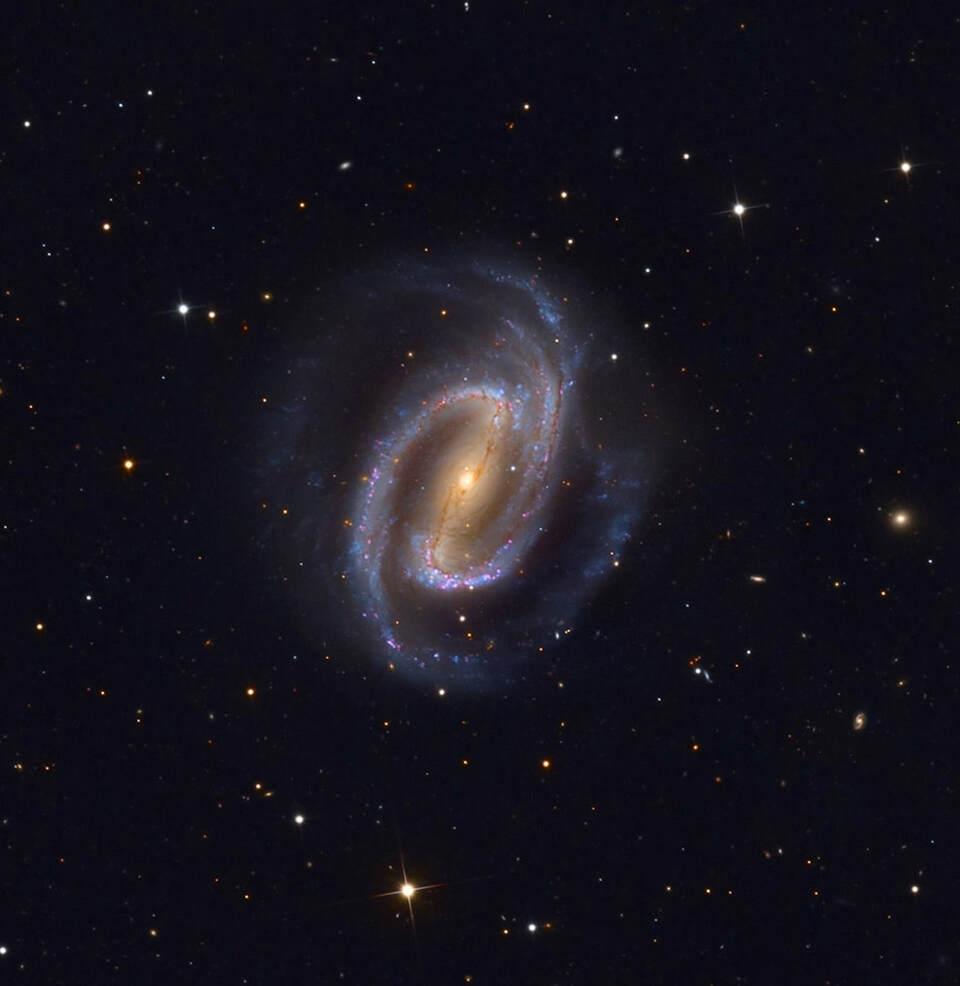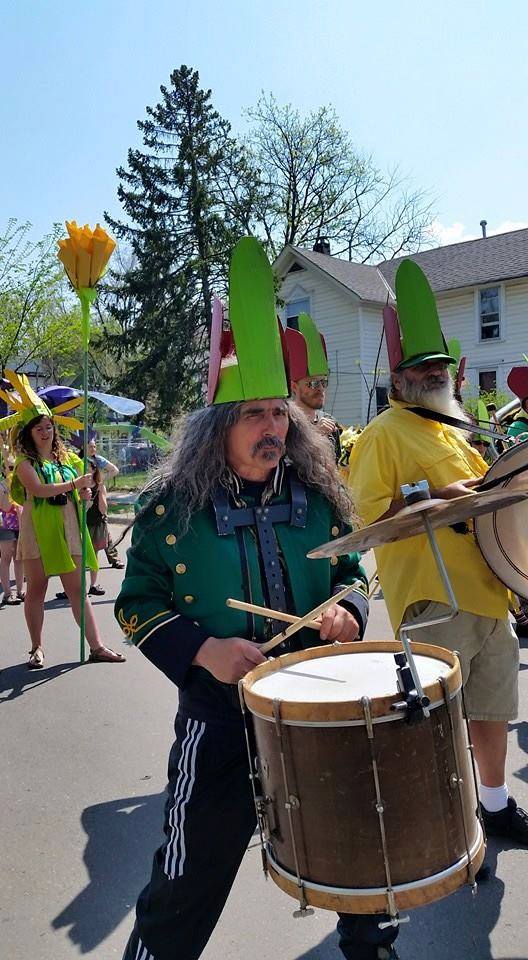Blog
This detailed image features Abell 3827, a galaxy cluster that offers a wealth of exciting possibilities for study. It was observed by Hubble in order to study dark matter, which is one of the greatest puzzles cosmologists face today. The science team used Hubble’s Advanced Camera for Surveys (ACS) and Wide Field Camera 3 (WFC3) to complete their observations. The two cameras have different specifications and can observe different parts of the electromagnetic spectrum, so using them both allowed the astronomers to collect more complete information. Abell 3827 has also been observed previously by Hubble, because of the interesting gravitational lens at its core. Looking at this cluster of hundreds of galaxies, it is amazing to recall that until less than 100 years ago, many astronomers believed that the Milky Way was the only galaxy in the Universe. The possibility of other galaxies had been debated previously, but the matter was not truly settled until Edwin Hubble confirmed that the Great Andromeda Nebula was in fact far too distant to be part of the Milky Way. The Great Andromeda Nebula became the Andromeda Galaxy, and astronomers recognised that our Universe was much, much bigger than humanity had imagined. We can only imagine how Edwin Hubble — after whom the Hubble Space Telescope was named — would have felt if he’d seen this spectacular image of Abell 3827.

James Joseph Brown (May 3, 1933 – December 25, 2006) was an American singer, songwriter, dancer, musician, record producer, and bandleader. The central progenitor of funk music and a major figure of 20th-century music, he is often referred to by the honorific nicknames “Godfather of Soul”, “Mr. Dynamite”, and “Soul Brother No. 1”. In a career that lasted over 50 years, he influenced the development of several music genres. Brown was one of the first ten inductees into the Rock and Roll Hall of Fame at its inaugural induction in New York on January 23, 1986.
Brown began his career as a gospel singer in Toccoa, Georgia. He came to national public attention in the mid-1950s as the lead singer of the Famous Flames, a rhythm and blues vocal group founded by Bobby Byrd. With the hit ballads “Please, Please, Please” and “Try Me“, Brown built a reputation as a tireless live performer with the Famous Flames and his backing band, sometimes known as the James Brown Band or the James Brown Orchestra. His success peaked in the 1960s with the live album Live at the Apollo and hit singles such as “Papa’s Got a Brand New Bag“, “I Got You (I Feel Good)” and “It’s a Man’s Man’s Man’s World“.
During the late 1960s, Brown moved from a continuum of blues and gospel-based forms and styles to a profoundly “Africanized” approach to music-making, emphasizing stripped-down interlocking rhythms that influenced the development of funk music. By the early 1970s, Brown had fully established the funk sound after the formation of the J.B.s with records such as “Get Up (I Feel Like Being a) Sex Machine” and “The Payback“. He also became noted for songs of social commentary, including the 1968 hit “Say It Loud – I’m Black and I’m Proud“. Brown continued to perform and record until his death from pneumonia in 2006.
Brown recorded 17 singles that reached No. 1 on the Billboard R&B charts. He also holds the record for the most singles listed on the BillboardHot 100 chart that did not reach No. 1. Brown was inducted into the first class of the Rhythm & Blues Music Hall of Fame in 2013 as an artist and then in 2017 as a songwriter. He also received honors from several other institutions, including inductions into the Black Music & Entertainment Walk of Fame, and the Songwriters Hall of Fame. In Joel Whitburn‘s analysis of the Billboard R&B charts from 1942 to 2010, Brown is ranked No. 1 in The Top 500 Artists.He is ranked seventh on Rolling Stone‘s list of the 100 Greatest Artists of All Time.
more...James Milton Cleveland (May 3, 1926 – August 23, 2008) was an American jazz trombonist born in Wartrace, Tennessee.
Cleveland was signed by EmArcy Records in 1955. Cleveland was married to jazz vocalist Janet Thurlow. He died on August 23, 2008, in Lynwood, California, at the age of 82.
more...John Aaron Lewis (May 3, 1920 – March 29, 2001) was an American jazz pianist, composer and arranger, best known as the founder and musical director of the Modern Jazz Quartet.
John Lewis was born in La Grange, Illinois, and after his parents’ divorce moved with his mother, a trained singer, to Albuquerque, New Mexico when he was two months old. She died from peritonitis when he was four and he was raised by his grandmother and great-grandmother. He began learning classical music and piano at the age of seven. His family was musical and had a family band that allowed him to play frequently and he also played in a Boy Scout music group. Even though he learned piano by playing the classics, he was exposed to jazz from an early age because his aunt loved to dance and he would listen to the music she played. He attended the University of New Mexico, where he led a small dance band that he formed and double majored in Anthropology and Music.
more...Peter Seeger (May 3, 1919 – January 27, 2014) was an American folk singer and social activist.
A fixture on nationwide radio in the 1940s, Seeger also had a string of hit records during the early 1950s as a member of the Weavers, most notably their recording of Lead Belly‘s “Goodnight, Irene“, which topped the charts for 13 weeks in 1950. Members of the Weavers were blacklisted during the McCarthy Era. In the 1960s, Seeger re-emerged on the public scene as a prominent singer of protest music in support of international disarmament, civil rights, counterculture, workers’ rights, and environmental causes.
A prolific songwriter, his best-known songs include “Where Have All the Flowers Gone?” (with additional lyrics by Joe Hickerson), “If I Had a Hammer (The Hammer Song)” (with Lee Hays of the Weavers), “Kisses Sweeter Than Wine” (also with Hays), and “Turn! Turn! Turn!“, which have been recorded by many artists both in and outside the folk revival movement. “Flowers” was a hit recording for the Kingston Trio (1962); Marlene Dietrich, who recorded it in English, German and French (1962); and Johnny Rivers (1965). “If I Had a Hammer” was a hit for Peter, Paul and Mary (1962) and Trini Lopez (1963) while the Byrds had a number one hit with “Turn! Turn! Turn!” in 1965.
Seeger was one of the folk singers responsible for popularizing the spiritual “We Shall Overcome” (also recorded by Joan Baez and many other singer-activists), which became the acknowledged anthem of the Civil Rights Movement, soon after folk singer and activist Guy Carawan introduced it at the founding meeting of the Student Nonviolent Coordinating Committee (SNCC) in 1960. In the PBS American Masters episode “Pete Seeger: The Power of Song“, Seeger said it was he who changed the lyric from the traditional “We will overcome” to the more singable “We shall overcome”.
more...Indian sitar virtuoso Pandit Devbrata Chaudhuri, also known as Debu Chaudhuri, died on May 1, 2021 at a Delhi hospital of COVID19-related complications. He was 85 years old.
Debu Chaudhuri was one of India’s leading sitar players. He belonged to the Senia Gharana of music. His awards included the Padma Bhushan (the third-highest civilian award in the Republic of India) and the Padma Shri.
more...The dark ominous figures are actually molecular clouds, knots of molecular gas and dust so thick they have become opaque. In comparison, however, these clouds are typically much less dense than Earth’s atmosphere. Featured here is a detailed image of the core of the Carina Nebula, a part where both dark and colorful clouds of gas and dust are particularly prominent. The image was captured in mid-2016 from Siding Spring Observatory in Australia. Although the nebula is predominantly composed of hydrogen gas — here colored green, the image was assigned colors so that light emitted by trace amounts of sulfur and oxygen appear red and blue, respectively. The entire Carina Nebula, cataloged as NGC 3372, spans over 300 light years and lies about 7,500 light-years away in the constellation of Carina. Eta Carinae, the most energetic star in the nebula, was one of the brightest stars in the sky in the 1830s, but then faded dramatically.

May 3rd 1933
Legendary and highly-respected Philadelphia pianist / keyboardist Eddie Green was a sideman on dozens of projects, and finally released two CDs as a leader, the long out-of-print debut “This One’s For You” and his posthumously-released coda Shades of Green.
After informal tutoring with Bud and Richie Powell and studying harmony, theory, composition and arranging at Combs College of Music, Eddie Green performed with the likes of Dexter Gordon, Slide Hampton, Donald Byrd, Hank Crawford, Max Roach, Betty Carter, Gary Bartz, George Coleman, Junior Cook and many others. He was on records that went “gold:” Billy Paul’s “Me and Mrs. Jones” and Lou Rawls’ “When You’ve Heard Lou, You’ve Heard It All.” His distinctive touch graced albums by guitar virtuoso Pat Martino, Sonny Criss and Jean Carn; in addition to his musicianship, his talents as as a composer were spotlighted on recordings by his own groundbreaking ’70s fusion group Catalyst, the Odean Pope Saxophone Choir, Rochelle Ferrelle and Suzanne Cloud.
Green appeared internationally at the Mt. Fuji (Japan), North Sea (Holland), Montreaux (Switzerland) and Nice (France) Jazz Festivals. Locally in Philadelphia, he was awarded honors by the Trane Stop Resource Institute, the City of Philadelphia and the Mill Creek Jazz and Cultural Society for both the 1993 and 1994 “Reader’s Choice” Best Jazz Piano.
more...Richard Arnold “Groove” Holmes (May 2, 1931 – June 29, 1991) was an American jazz organist who performed in the hard bop and soul jazzgenre. He is best known for his 1965 recording of “Misty“.
Holmes’s first album, on Pacific Jazz with guest Ben Webster, was recorded in March 1961. He recorded many albums for Pacific Jazz, Prestige, Groove Merchant, and Muse, many of them with Houston Person.
He died of a heart attack after battling prostate cancer, having performed his last concerts in a wheelchair. One of his last gigs was at the 1991 Chicago Blues Festival with his longtime friend, singer Jimmy Witherspoon.
more...NGC 1300 is a barred spiral galaxy located about 61 million light-years away in the constellationEridanus. The galaxy is about 110,000 light-years across (about the same size of the Milky Way). It is a member of the Eridanus Cluster, a cluster of 200 galaxies. It was discovered by John Herschel in 1835.
In the core of the larger spiral structure of NGC 1300, the nucleus shows a “grand-design” spiral structure that is about 3,300 light-years long. Only galaxies with large-scale bars appear to have these grand-design inner disks — a spiral within a spiral. Models suggest that the gas in a bar can be funneled inwards, and then spiral into the center through the grand-design disk, where it can potentially fuel a central supermassive black hole (SMBH). NGC 1300 is not known to have an active nucleus, indicating that its central black hole is not accreting matter.

Judith Marjorie Collins (born May 1, 1939) is a Grammy Award-winning American singer and songwriter with a career spanning over 60 years. She is known for her eclectic tastes in the material she records (which has included folk music, show tunes, pop music, rock and roll and standards) for her social activism, and for the clarity of her voice. Collins has released 28 studio albums, 4 live albums, numerous compilation albums and 4 holiday albums.
Collins’ debut album A Maid of Constant Sorrow was released in 1961, but it was the lead single from her 1967 album Wildflowers, “Both Sides, Now” – written by Joni Mitchell – that gave Collins international prominence. The single hit the Top 10 on the Billboard Pop Singles chart and won Collins her first Grammy Award for Best Folk Performance. She enjoyed further success with her recordings of “Someday Soon“, “Chelsea Morning“, “Amazing Grace“, and “Cook with Honey”.
Collins experienced the biggest success of her career with her recording of Stephen Sondheim‘s “Send in the Clowns” from her best-selling 1975 album Judith. The single charted on the Billboard Pop Singles chart in 1975 and then again in 1977, spending 27 non-consecutive weeks on the chart and earning Collins a Grammy Award nomination for Best Pop Vocal Performance, Female, as well as a Grammy Award for Sondheim for Song of the Year. In 2017, Collins’ rendition of the song “Amazing Grace” was selected for preservation in the National Recording Registry by the Library of Congress as being “culturally, historically, or artistically significant”. In 2019, Judy Collins scored her first #1 album on an American Billboard Chart with Winter Stories at the age of 80 years old.
more...Shirley Valerie Horn (May 1, 1934 – October 20, 2005) was an American jazz singer and pianist. She collaborated with many jazz greats including Miles Davis, Dizzy Gillespie, Toots Thielemans, Ron Carter, Carmen McRae, Wynton Marsalis and others. She was most noted for her ability to accompany herself with nearly incomparable independence and ability on the piano while singing, something described by arranger Johnny Mandel as “like having two heads”, and for her rich, lush voice, a smoky contralto, which was described by noted producer and arranger Quincy Jones as “like clothing, as she seduces you with her voice”.
Shirley Horn was born and raised in Washington, D.C.. Encouraged by her grandmother, an amateur organist, Horn began piano lessons at the age of four. Aged 12, she studied piano and composition at Howard University, later graduating from there in classical music. Horn was offered a place at the Juilliard School, but her family could not afford to send her there. Horn formed her first jazz piano trio when she was 20. Horn’s early piano influences were Erroll Garner, Oscar Peterson and Ahmad Jamal, and moving away from her classical background, Horn later said that “Oscar Peterson became my Rachmaninov, and Ahmad Jamal became my Debussy.” She then became enamored with the famous U Street jazz area of Washington (largely destroyed in the 1968 riots), sneaking into jazz clubs before she was of legal age.
more...Marion Walter Jacobs (May 1, 1930 – February 15, 1968), known as Little Walter, was an American blues musician, singer, and songwriter, whose revolutionary approach to the harmonica had a strong impact on succeeding generations, earning him comparisons to such seminal artists as Django Reinhardt, Charlie Parker and Jimi Hendrix. His virtuosity and musical innovations fundamentally altered many listeners’ expectations of what was possible on blues harmonica. He was inducted into The Rock and Roll Hall of Fame in 2008, the first and, to date, only artist to be inducted specifically as a harmonica player.
Jacobs’ date of birth is usually given as May 1, 1930, in Marksville, Louisiana. He was born without a birth certificate and when he applied for a Social Security card in 1940, his birthdate was listed as May 1, 1923 (over the years he often gave different years, but May 1 was constant. In some other documents he filled out before reaching the age of majority he indicated birth years of 1925 and 1928, probably to appear to be of legal age to sign contracts for recordings and club work. After reaching the age of majority based on a birth year of 1930, he consistently gave his birth year as 1930). He was raised in Rapides Parish, Louisiana, where he learned to play the harmonica. He quit school and by the age of 12 had left rural Louisiana and travelled, working odd jobs and busking on the streets of New Orleans, Memphis, Helena and West Helena, Arkansas, and St. Louis. He honed his musical skills on harmonica and guitar, performing with older bluesmen including Sonny Boy Williamson II, Sunnyland Slim, Honeyboy Edwards, and others. A few months after returning from his second European tour, Little Walter was involved in a fight while taking a break from a performance at a nightclub on the South Side of Chicago. He apparently sustained only minor injuries in this altercation, but they aggravated the damage he had suffered in previous violent encounters, and he died in his sleep at the apartment of a girlfriend, at 209 East 54th Street in Chicago early the following morning. The official cause of death stated on Little Walter’s death certificate was coronary thrombosis (a blood clot in the heart); evidence of external injuries was so insignificant that the police reported that his death was due to “unknown or natural causes”, and no external injuries were noted on the death certificate. His body was buried at St. Mary’s Cemetery, in Evergreen Park, Illinois, on February 22, 1968. Little Walter’s grave remained unmarked until 1991, when fans Scott Dirks and Eomot Rasun had a marker designed and installed.
more...More Posts
- Cosmos Rho Ophiuchi JWST
- Roger McGuinn
- Albert Ayler
- Pete Escovedo
- Leroy Vinnegar
- Daily Roots Butch Cassidy Sound System
- Cosmos NGC 1398
- Christine McVie
- Big John Patton
- Paul Gonsalves
- World Music Saîdê Goyî
- Daily Roots Augustus Pablo
- Cosmos NGC 6559
- Oscar León
- Terry Garthwaite
- World Music Keturah
- Daily Roots Johnny Clarke
- Cosmos eMACS J1353.7+4329
- Arlo Guthrie
- Bela Fleck
